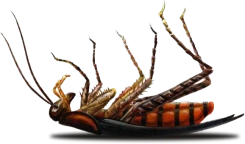What’s Going on with these Killer Hornets?
If you’ve been following the news recently, there’s a good chance you’ve heard about the Asian giant hornets that have been found on the west coast as early as December, with growing concerns in April. But what’s the buzz with them and should we be worried? Let’s delve into the research and see what’s known about these killer hornets.
If you’re not yet familiar, the Asian giant hornet, also known as the killer hornet, is a wasp that grows to be about 1.4-2.2 inches in length with a wingspan of 1.4-3.0 inches – size difference depending on social caste level – making them the largest wasp in the world. The color pattern is similar to a yellowjacket – a yellow-orange head, black thorax, and yellow and black striped abdomen, with gray wings. Common of all social wasps, the worker females have a stinger, the queen has an ovipositor to lay eggs in the spring, and the males, or drones, are stingless. As the name implies, they are naturally found in Asia, most notably Japan, and live in the low mountains or dense forests, making nests underground, often using old rodent burrows or pine roots, with the nests being as deep as two feet. These subterranean nests, along with assistance from the workers, help the queen overwinter and start the colony up in the spring. Males have the shortest lifespan, surviving for about 5-7 months until the fall, workers survive for about 7-9 months until the winter, and queens survive for about one year until next winter. They are omnivorous, feeding primarily on insects and plant products, with a specialty of staging mass attacks on honey bees, and feed a paste made of their prey to the larvae that develop in the spring or summer.
So, what does this mean for the United States, now that these hornets have been found along the Pacific coast? For starters, the sting is painful, akin to hot metal driving into your skin, and the powerful venom carried by the workers can be rather potent. When several stings are given to a mammal, the venom can cause kidney and liver failure if left alone, which kills around 30-50 people in Japan each year. The hornets aren’t particularly territorial, however, and have only been seen to attack if disturbed or threatened, and with an average flying speed of 25 miles per hour, it is best to leave them alone if found. The second concern is that they are well-known for raiding honey bee hives and viciously slaughtering the bees inside, leading to devastating losses among beekeepers and the honey industry. A group of 20-30 Asian giant hornets are estimated to kill 5,000-25,000 honey bees within 1-6 hours, leading to over ten thousand hives destroyed each year. Entomologists and biologists have hypothesized that these hornets came to the United States either on a cargo ship or by someone looking to cultivate them as a food source, as they are a popular treat and nutrition supplement in Asia and parts of Europe.
Do we need to worry about the appearance of these killer hornets? As of right now, only small populations have been found around Washington state, not big enough to establish a viable colony, and on top of that, scientists and beekeepers have begun strong efforts to control the hornets and detect populations elsewhere via radio monitoring. Although the Asian giant hornet doesn’t need to be anywhere near the top of your list of insects to be concerned about right now, scientists are recommending to avoid interaction with hornets you come across and to alert your local Department of Agriculture if you stumble upon what you believe to be a giant hornet.
Information sources for additional reading:
Animal Diversity Web: https://animaldiversity.org/accounts/Vespa_mandarinia/#physical_description
New York Times: https://www.nytimes.com/2020/05/02/us/asian-giant-hornet-washington.html?utm_source=pocket-newtab
Encyclopedia of Life (Archived): https://web.archive.org/web/20131007102255/https://eol.org/data_objects/26420945
Popular Science: https://www.popsci.com/story/animals/murder-hornet-bee/


Why Choose Us?
Providing Reliable Pest & Wildlife Solutions Since 1939
At Home Paramount Pest Control, we have been dedicated to delivering reliable pest and wildlife management solutions for over 80 years. Our long-standing presence in the industry speaks volumes about our commitment to excellence and customer satisfaction. When you trust our team, you can always count on:
- Customized solutions to suit your specific needs
- Same-day service availability for pest infestation emergencies
- High-quality green products that are safe for the environment
- Complimentary pest inspections
- Affordable financing solutions tailored to your budget
Call us at 888-888-4663 to get started with a free pest inspection for your property today!
Learn More

